Portworx Guided Hands On-Labs. Register Now
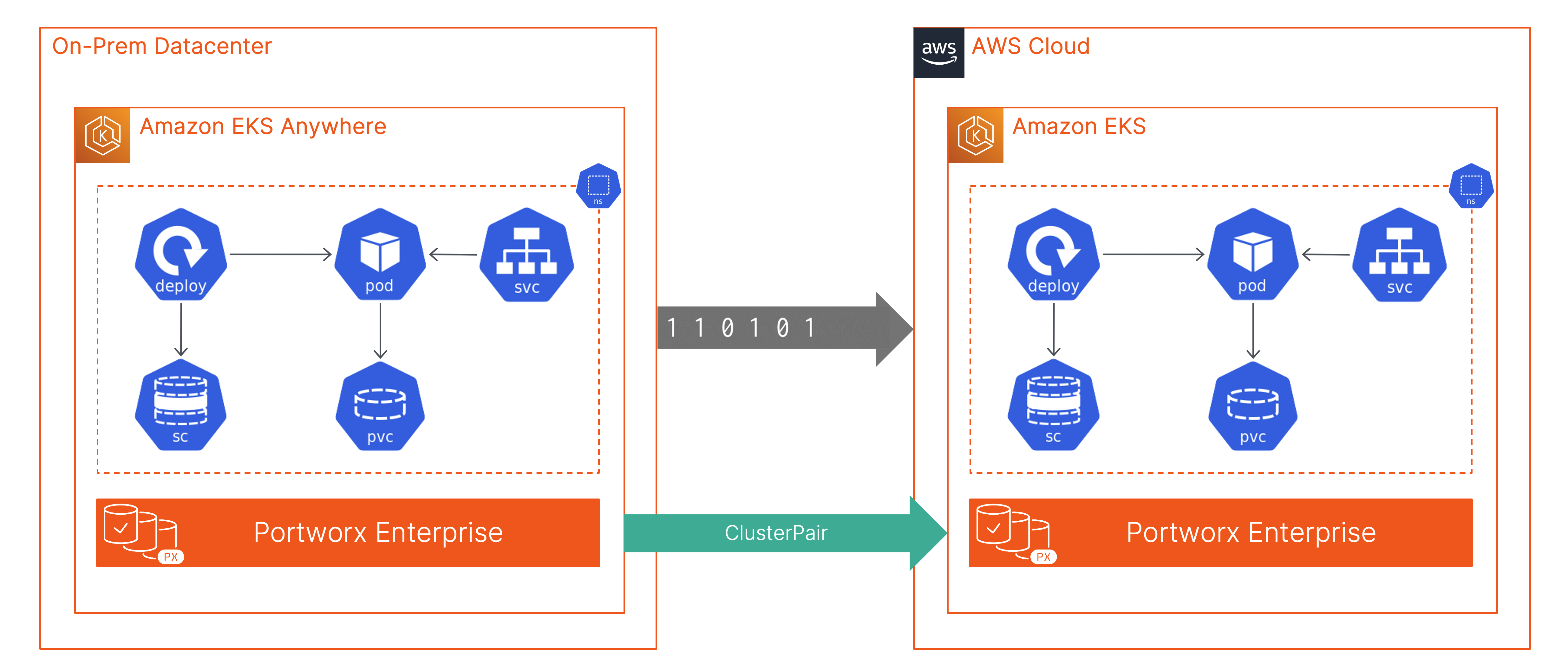
The recent CNCF annual survey reveals that 79% of the respondents use certified Kubernetes hosted platforms to run their containerized applications. Of those, the most popular Kubernetes platform is the Amazon Elastic Container Service for Kubernetes (EKS), with a 39% market share.
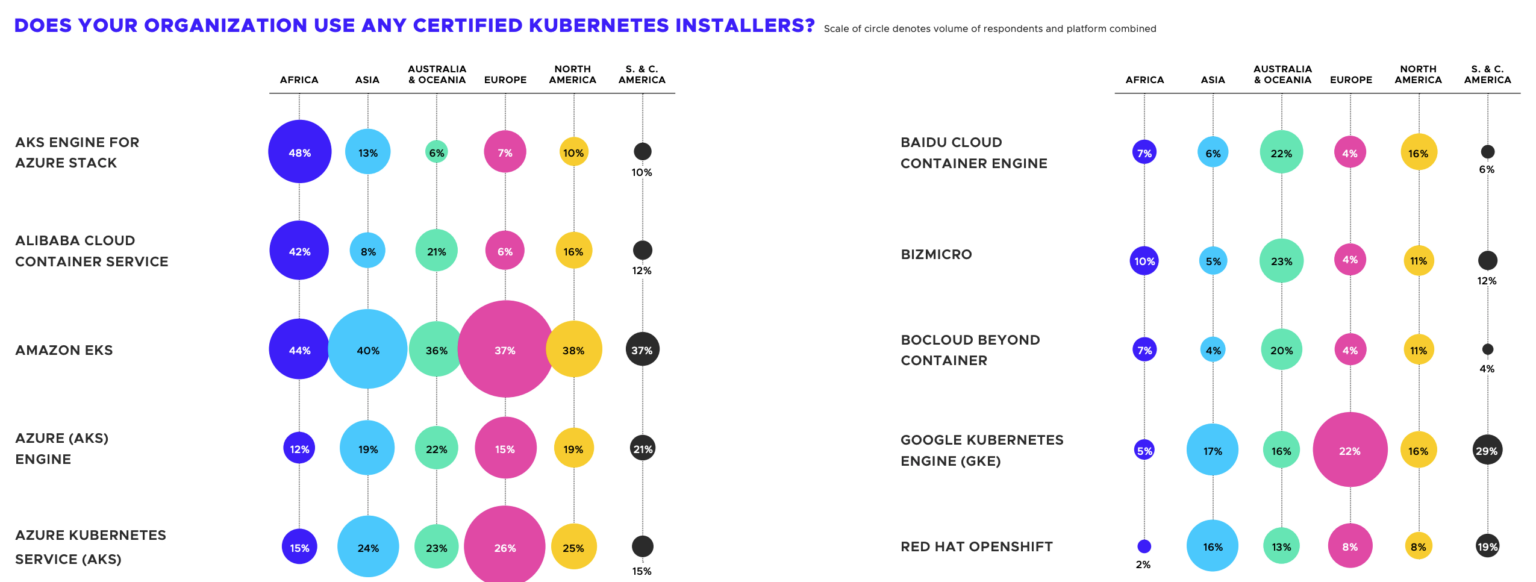
In September 2021, Amazon announced general availability for Amazon EKS Anywhere, which provides another deployment option for users who want to run Kubernetes clusters inside their own datacenter environments. Both Amazon EKS and Amazon EKS Anywhere are powered by EKS Distro, an open-source distribution for Kubernetes maintained by AWS, bringing a consistent experience to users regardless of where they are running their modern applications.
In the last blog, we discussed how Portworx can complement Amazon EKS Anywhere by providing a consistent Kubernetes storage layer across your clusters, whether they are running in the public cloud or on-prem inside your own datacenter environments. In this blog, we will talk about how you can leverage Portworx to migrate your containerized applications across hybrid cloud to achieve the true benefits of data portability promised by Kubernetes.
To configure an application migration solution, you will need an Amazon EKS and an Amazon EKS Anywhere cluster configured with Portworx deployed as the Kubernetes storage layer. Once you have Portworx up and running, follow the next steps to migrate an application running in the “demo” namespace on the Amazon EKS Anywhere cluster (source cluster) to your Amazon EKS cluster (destination cluster).
- Install storkctl on your jump host that you are using to access your source and destination clusters:
STORK_POD=$(kubectl get pods -n kube-system -l name=stork -o jsonpath='{.items[0].metadata.name}') &&
kubectl cp -n kube-system $STORK_POD:/storkctl/linux/storkctl ./storkctl
sudo mv storkctl /usr/local/bin &&
sudo chmod +x /usr/local/bin/storkctl
- Access your destination cluster and create a new service account and a cluster role binding. Using service accounts instead of user accounts for migrations helps avoid any Kubernetes token expiration-related errors. To learn more about the difference between service accounts and user accounts, you can read the official Kubernetes documentation. You can also choose to use token based migration for one time migration options.
cat > service-account-migration.yaml <<_EOF apiVersion: v1 kind: ServiceAccount metadata: name: migration namespace: demo #Namespace where your app is running EOF kubectl apply -f service-account-migration.yaml
- Create a cluster role binding to associate the service account with the cluster role—cluster-admin:
cat > cluster-role-binding-migration.yaml <<_EOF apiVersion: rbac.authorization.k8s.io/v1 kind: ClusterRoleBinding metadata: name: migration-clusterrolebinding roleRef: apiGroup: rbac.authorization.k8s.io kind: ClusterRole name: cluster-admin subjects: - kind: ServiceAccount name: migration namespace: demo EOF kubectl apply -f cluster-role-binding-migration.yaml
- Generate a kubeconfig file using the above service account:
SERVICE_ACCOUNT=migration
NAMESPACE=demo
SERVER=https://<SERVER-ADDRESS:PORT> #EKS Endpoint
SERVICE_ACCOUNT_TOKEN_NAME=$(kubectl -n ${NAMESPACE} get serviceaccount ${SERVICE_ACCOUNT} -o jsonpath='{.secrets[].name}')
SERVICE_ACCOUNT_TOKEN=$(kubectl -n ${NAMESPACE} get secret ${SERVICE_ACCOUNT_TOKEN_NAME} -o "jsonpath={.data.token}" | base64 --decode)
SERVICE_ACCOUNT_CERTIFICATE=$(kubectl -n ${NAMESPACE} get secret ${SERVICE_ACCOUNT_TOKEN_NAME} -o "jsonpath={.data['ca\.crt']}")
cat <<END
apiVersion: v1
kind: Config
clusters:
- name: default-cluster
cluster:
certificate-authority-data: ${SERVICE_ACCOUNT_CERTIFICATE}
server: ${SERVER}
contexts:
- name: default-context
context:
cluster: default-cluster
namespace: ${NAMESPACE}
user: ${SERVICE_ACCOUNT}
current-context: default-context
users:
- name: ${SERVICE_ACCOUNT}
user:
token: ${SERVICE_ACCOUNT_TOKEN}
END
#Save the above script in a file called create-migration-config.sh file and then use the following command to generate a kubeconfig file.
chmod +x create-migration-config.sh && ./create-migration-config.sh > ~/.kube/migration-config.conf
- Set the value of the KUBECONFIG environment variable to point to the kubeconfig file we generated in the previous step:
export KUBECONFIG=~/.kube/migration-config.conf
- Next, let’s go ahead and generate a clusterpair spec using this service account. To do that, we will use the following command:
storkctl generate clusterpair eks-clusterpair --kubeconfig ~/.kube/migration-config.conf -n demo > eks-clusterpair.yaml
- Let’s customize the eks-clusterpair.yaml and configure the options to match our destination cluster.
options: ip: "<ip-address-of-node-in-the-destination-cluster>" port: "<port_of_remote_px_node_default_9001>" token: "<token_generated_from_destination_cluster>"
You can edit the portworx-service in the kube-system namespace to set it to “loadBalancer.” And to generate a cluster token, exec into one of the Portworx pods on the destination cluster and run the following command:
Note: Do not enable load balancing without authorization enabled on the Portworx cluster.
PX_POD=$(kubectl get pods -n kube-system -l name=portworx -o \
jsonpath='{.items[0].metadata.name}')
kubectl exec -it $PX_POD -n kube-system -- /opt/pwx/bin/pxctl cluster token show
- Let’s copy this eks-clusterpair.yaml file over to your source cluster and apply it using the following commands:
kubectl create ns demo kubectl apply -f eks-clusterpair.yaml -n demo
- Monitor the clusterpair creation using the following commands:
storkctl get clusterpair -n demo NAME STORAGE-STATUS SCHEDULER-STATUS CREATED eks-clusterpair Ready Ready 12 Mar 22 03:11 UTC
- Once both the storage status and schedule status are ready, we can go ahead and create a migration spec yaml file.
cat > app-migration.yaml <<_EOF apiVersion: stork.libopenstorage.org/v1alpha1 kind: Migration metadata: name: <YOUR_MIGRATION_OBJECT> namespace: <YOUR_MIGRATION_NAMESPACE> spec: clusterPair: <YOUR_CLUSTER_PAIR> includeResources: true # If set to false this will migrate only the Portworx volumes. No PVCs, apps, etc will be migrated startApplications: true # Deploys app pods on the destination cluster namespaces: - <NAMESPACE_TO_MIGRATE> purgeDeletedResources: false # boolean value specifying if STORK should automatically purge a resource from the destination cluster when you delete it from the source cluster. EOF kubectl apply -f app-migration.yaml -n demo
- You can monitor the migration progress by using the following commands:
storkctl get migrations -n demo NAME CLUSTERPAIR STAGE STATUS VOLUMES RESOURCES CREATED appmigration eks-cluster Volumes InProgress 0/1 0/0 12 Mar 22 20:04 UTC
- Once the migration is successful, you should see the following status:
storkctl get migrations -n demo NAME CLUSTERPAIR STAGE STATUS VOLUMES RESOURCES CREATED appmigration eks-cluster Final Successful 1/1 3/3 12 Mar 22 20:10 UTC
- You can also verify the migration is successful by using the following commands on the destination cluster:
kubectl get all -n demo kubectl get pvc -n demo
Application migrations using Portworx allow you to migrate your containerized applications seamlessly across the hybrid cloud (Amazon EKS Anywhere and Amazon EKS). If you want to look at a demo of all this in action, watch the YouTube video below:
Share
Subscribe for Updates
About Us
Portworx is the leader in cloud native storage for containers.
Thanks for subscribing!

Bhavin Shah
Sr. Technical Marketing Manager | Cloud Native BU, Pure StorageExplore Related Content:
- Amazon EKS
- kubernetes
- portworx
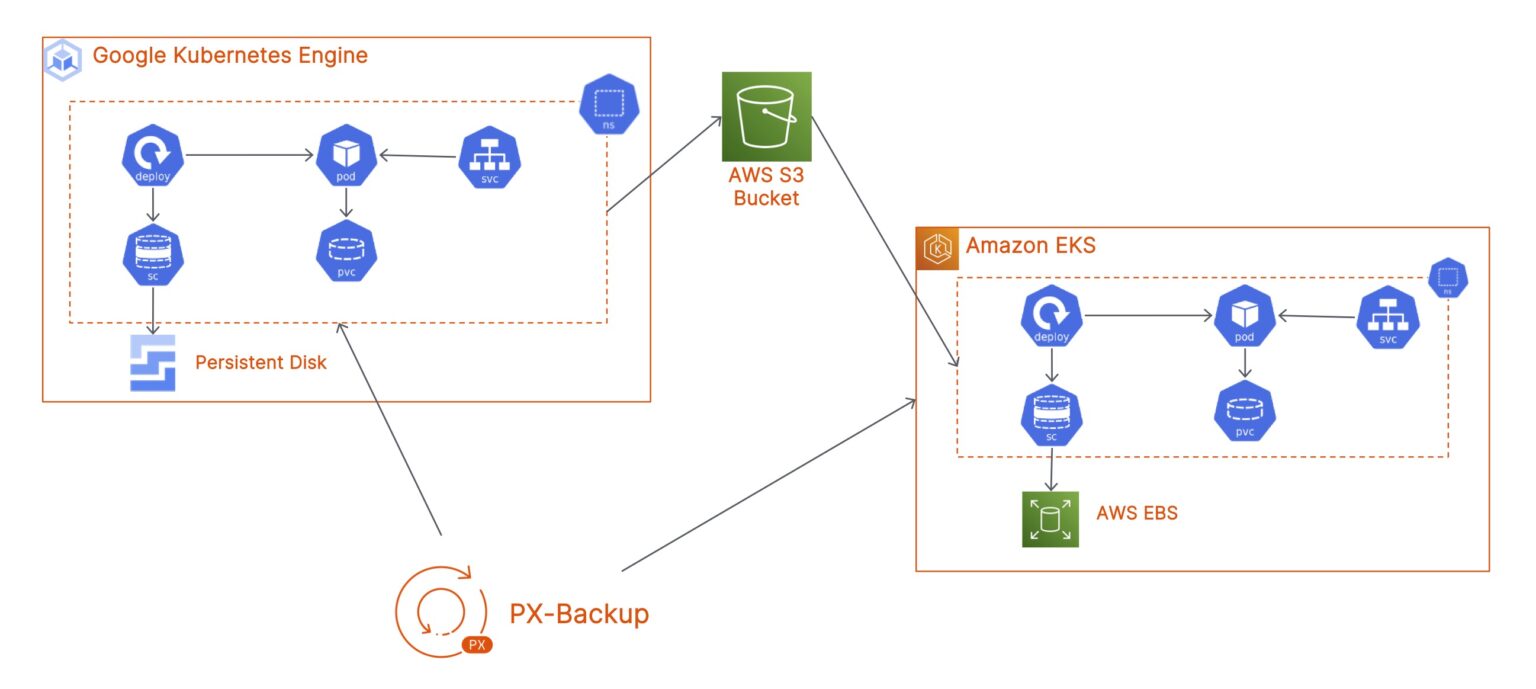
Cross-cloud Data Protection using PX-Backup - Migrate your applications from GKE to EKS

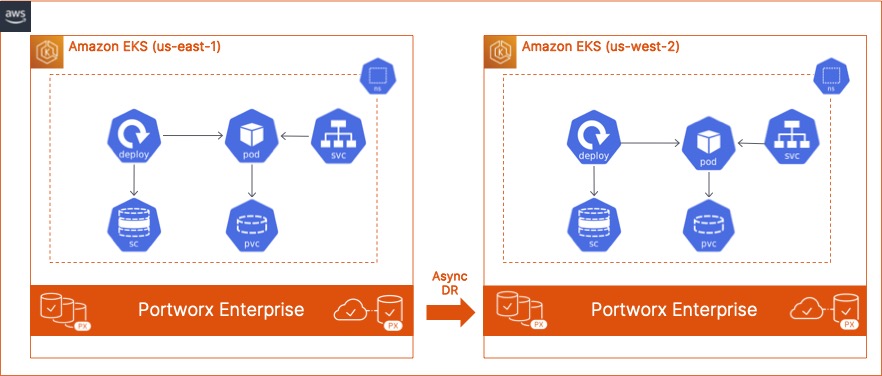
How to build an Async Disaster Recovery Solution for Amazon EKS clusters using Portworx PX-DR

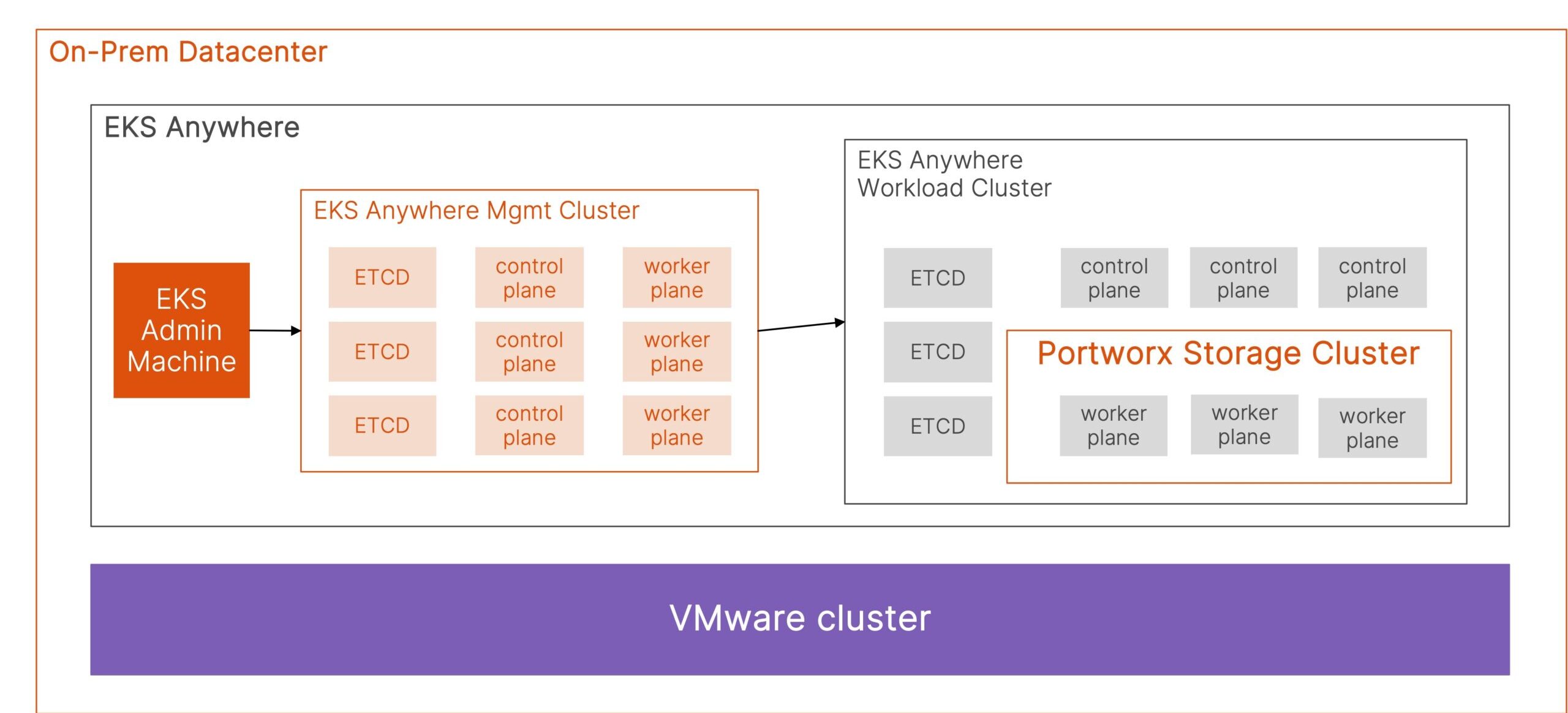
Getting started with Amazon EKS Anywhere and Portworx for your hybrid cloud deployments


